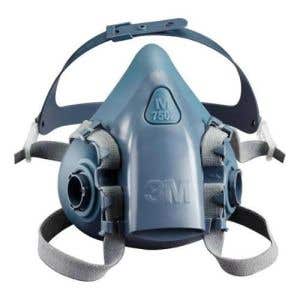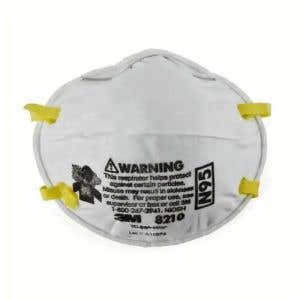What Are The Three Types of Respirators?
The purpose of this article is to highlight the possible alternative types of respirators for use in healthcare workplaces to help protect workers from infectious airborne biological particles, such as viruses and bacteria.
When respiratory protection is recommended to help reduce exposure to biological hazards, the U.S. Centers for Disease Control and Prevention (CDC), the European Centre for Disease Prevention and Control (ECDC), and the World Health Organization (WHO) often recommend respirators at least as protective as an N95, FFP2, or similar particulate respirator. All filtering facepiece respirators that are certified as N95, FFP2, KN95, or similar can, when properly selected and worn, effectively filter airborne biological particles such as viruses and bacteria.2-5 Surgical filtering facepiece respirators are also cleared as surgical masks by the U.S. Food and Drug Administration (FDA), the European Union Notified Bodies, or an equivalent authority in other countries.


Types of Respirators
[/split_line_heading][divider line_type="No Line"][vc_column_text]There are three types of respirator for use in healthcare include:[/vc_column_text][divider line_type="No Line"][vc_row_inner column_margin="default" text_align="left"][vc_column_inner column_padding="no-extra-padding" column_padding_position="all" background_color_opacity="1" background_hover_color_opacity="1" column_shadow="none" column_border_radius="none" width="1/3" column_border_width="none" column_border_style="solid"][image_with_animation image_url="12437" alignment="" animation="Fade In" border_radius="none" box_shadow="none" max_width="100%"][divider line_type="No Line"][vc_column_text]Non-surgical filtering facepiece respirators[/vc_column_text][divider line_type="No Line"][nectar_btn size="small" button_style="regular" button_color_2="Accent-Color" icon_family="default_arrow" url="https://sg.electgo.com/brands/3m?utf8=%E2%9C%93&search=3M+Mask" text="Shop Now"][/vc_column_inner][vc_column_inner column_padding="no-extra-padding" column_padding_position="all" background_color_opacity="1" background_hover_color_opacity="1" column_shadow="none" column_border_radius="none" width="1/3" column_border_width="none" column_border_style="solid"][image_with_animation image_url="1569" alignment="" animation="Fade In" border_radius="none" box_shadow="none" max_width="100%"][divider line_type="No Line"][divider line_type="No Line"][vc_column_text]Reusable (elastomeric) respirators [/vc_column_text][divider line_type="No Line"][divider line_type="No Line"][nectar_btn size="small" button_style="regular" button_color_2="Accent-Color" icon_family="default_arrow" url="https://sg.electgo.com/brands/3m?utf8=%E2%9C%93&search=Reusable+respirator" text="Shop Now"][/vc_column_inner][vc_column_inner column_padding="no-extra-padding" column_padding_position="all" background_color_opacity="1" background_hover_color_opacity="1" column_shadow="none" column_border_radius="none" width="1/3" column_border_width="none" column_border_style="solid"][image_with_animation image_url="12465" alignment="" animation="Fade In" border_radius="none" box_shadow="none" max_width="100%"][divider line_type="No Line"][divider line_type="No Line"][vc_column_text]Power air-purifying respirators (PAPRs)[/vc_column_text][divider line_type="No Line"][nectar_btn size="small" button_style="regular" button_color_2="Accent-Color" icon_family="default_arrow" url=" https://www.electgo.com/types-of-respirators/#enquire" text="I'm interested "][/vc_column_inner][/vc_row_inner][/vc_column][/vc_row][vc_row type="in_container" full_screen_row_position="middle" scene_position="center" text_color="dark" text_align="left" overlay_strength="0.3" shape_divider_position="bottom"][vc_column column_padding="no-extra-padding" column_padding_position="all" background_color_opacity="1" background_hover_color_opacity="1" column_shadow="none" column_border_radius="none" width="1/1" tablet_text_alignment="default" phone_text_alignment="default" column_border_width="none" column_border_style="solid"][vc_column_text]Here are some considerations to help healthcare organizations determine whether these other respirator types might work within their respiratory protection program. [/vc_column_text][divider line_type="No Line"][vc_column_text]| Key Attributes | Key Potential Advantages | Key Potential Limitations | Select Examples | |
 Non-surgical filtering facepiece respirators Non-surgical filtering facepiece respirators |
|
|
|
All 3M filtering facepiece respirators can filter biological particles, including these classes: • N95 • P95 • P100 |
 Elastomeric respirators Elastomeric respirators
|
|
|
|
Any 3M elastomeric facepiece equipped with appropriate 3M particulate filters, per applicable regulatory approvals, including:
|
 Powered air-purifying respirators (PAPRs) Powered air-purifying respirators (PAPRs)
|
|
|
|
All 3M PAPR particulate filters can filter biological particles |
3M Reusable Respirators
[/fancy_box][/vc_column_inner][vc_column_inner column_padding="no-extra-padding" column_padding_position="all" background_color_opacity="1" background_hover_color_opacity="1" column_shadow="none" column_border_radius="none" width="1/4" column_border_width="none" column_border_style="solid"][fancy_box box_style="default" icon_family="none" image_url="2342" color="Accent-Color"]3M Disposable Respirators
[/fancy_box][/vc_column_inner][vc_column_inner column_padding="no-extra-padding" column_padding_position="all" background_color_opacity="1" background_hover_color_opacity="1" column_shadow="none" column_border_radius="none" width="1/4" column_border_width="none" column_border_style="solid"][/vc_column_inner][vc_column_inner column_padding="no-extra-padding" column_padding_position="all" background_color_opacity="1" background_hover_color_opacity="1" column_shadow="none" column_border_radius="none" width="1/4" column_border_width="none" column_border_style="solid"][/vc_column_inner][/vc_row_inner][/vc_column][/vc_row][vc_row type="in_container" full_screen_row_position="middle" scene_position="center" text_color="dark" text_align="left" overlay_strength="0.3" shape_divider_position="bottom"][vc_column column_padding="no-extra-padding" column_padding_position="all" background_color_opacity="1" background_hover_color_opacity="1" column_shadow="none" column_border_radius="none" width="1/1" tablet_text_alignment="default" phone_text_alignment="default" column_border_width="none" column_border_style="solid"][image_with_animation image_url="12586" alignment="" animation="Fade In" border_radius="none" box_shadow="none" max_width="100%" img_link="https://share.hsforms.com/1Y_AO0eciQwKJyQJkMQ3cUQ4sq12"][/vc_column][/vc_row][vc_row type="in_container" full_screen_row_position="middle" scene_position="center" text_color="dark" text_align="left" id="enquire" overlay_strength="0.3" shape_divider_position="bottom" shape_type=""][vc_column column_padding="no-extra-padding" column_padding_position="all" background_color_opacity="1" background_hover_color_opacity="1" column_shadow="none" column_border_radius="none" width="1/1" tablet_text_alignment="default" phone_text_alignment="default" column_border_width="none" column_border_style="solid"][nectar_animated_title heading_tag="h3" style="color-strip-reveal" color="Accent-Color" text="Enquire Now"][gravityform id="7" title="false" description="false" ajax="false"][/vc_column][/vc_row][vc_row type="in_container" full_screen_row_position="middle" scene_position="center" text_color="dark" text_align="left" overlay_strength="0.3" shape_divider_position="bottom"][vc_column column_padding="no-extra-padding" column_padding_position="all" background_color_opacity="1" background_hover_color_opacity="1" column_shadow="none" column_border_radius="none" width="1/1" tablet_text_alignment="default" phone_text_alignment="default" column_border_width="none" column_border_style="solid"][nectar_animated_title heading_tag="h3" style="color-strip-reveal" color="Accent-Color" text="Discover More "][recent_posts style="slider_multiple_visible" category="3m" columns="4" button_color="Accent-Color" order="DESC" orderby="date" posts_per_page="4" post_offset="2"][/vc_column][/vc_row]Healthcare facilities often standardize on approved surgical filtering facepiece particulate respirators, sometimes also referred to as surgical N95s, healthcare respirators or medical respirators, for workers providing patient care. However, during disease outbreaks, or public health disasters, availability of approved surgical filtering facepiece respirators may become limited and organizations should evaluate whether other, more readily available, respirators would be appropriate for use. In many situations, it can be appropriate for healthcare workers to use respirators other than surgical or standard filtering facepiece respirators. The CDC indicates that healthcare facilities should consider and use alternatives to N95 respirators where feasible and appropriate. These include other classes of filtering facepiece respirators, elastomeric half-facepiece and full facepiece air purifying respirators and powered air purifying respirators (PAPRs). All of these alternatives will provide equivalent or higher respiratory protection than N95 respirators when properly selected and worn.
Types of Respirators
There are three types of respirators for use in healthcare include:






Non-surgical filtering facepiece respirators
Reusable (elastomeric) respirators
Power air-purifying respirators (PAPRs)
| Key Attributes | Key Potential Advantages | Key Potential Limitations | Select Examples | |
|
|
|
|
|
• N95 • P95 • P100 |
|
|
|
|
|
• 7093, 7093C filters • P100 filters
• 5N11 & 5P71 pre-filter assemblies
• 6092X Series filters – cartridges |
|
Powered air-purifying respirators (PAPRs) |
|
|
|
|
 Non-surgical filtering facepiece respirators
Non-surgical filtering facepiece respirators Elastomeric respirators
Elastomeric respirators



Share this article on social media